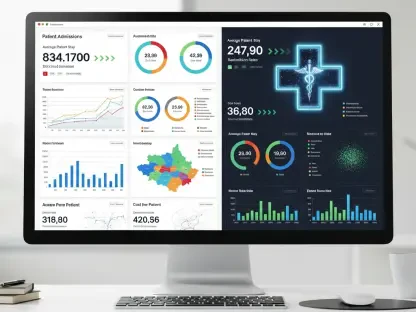In today’s world, the integration of artificial intelligence into healthcare provides enormous potential for advancements in medical diagnostics and treatments. Faisal Zain, a renowned expert in medical technology, delves into how AI models like Foresight are reshaping the landscape while highlighting privacy and ethical concerns.
What is the primary goal of the Foresight AI model, and how do you envision it assisting doctors in the future?
The primary goal of the Foresight AI model is to revolutionize healthcare by enabling predictive diagnostics. It aims to assist doctors in anticipating disease complications before they occur, which can shift the healthcare approach from reactive to preventive. This potential to forecast hospitalizations or heart attacks means doctors can intervene earlier, ultimately improving patient outcomes and reducing healthcare costs.
Can you explain what “national-scale generative AI model of health data” means?
A national-scale generative AI model refers to the vast, unprecedented scope of the Foresight AI system in processing and analyzing health data. It encompasses data from millions of health events recorded by the NHS in England, integrating diverse datasets—from hospital visits to vaccination records—to model complex health trends and individual diagnostic predictions on a national level.
What are the main datasets that Foresight uses, and how was this data collected?
Foresight utilizes eight distinct datasets routinely gathered by the NHS, which include outpatient appointments, hospital visits, and vaccination records. This data covers a wide spectrum of health events from November 2018 to December 2023, involving medical information from nearly 57 million people across England, collected through standard healthcare practices and appointments.
How do the creators of Foresight address privacy and data protection concerns when using such large health datasets?
The creators of Foresight are acutely aware of the privacy concerns and strive to ensure all data is “de-identified” before training the AI, meaning direct identifiers are removed. They have established secure mechanisms, like a custom-built NHS data environment, to maintain control over the data, reducing the risk of unintended exposure and access to non-authorized entities.
What measures are in place to ensure that sensitive patient data is not inadvertently revealed by the Foresight AI model?
To protect sensitive patient data, Foresight operates within a secured environment controlled by the NHS, only accessible to certified researchers. Additionally, rigorous data security protocols are bolstered by the AI model’s infrastructure, supported by companies like Amazon Web Services and Databricks, which provide essential computational capacities without compromising data privacy.
Could you elaborate on the challenges involved in truly anonymizing rich health data?
Anonymizing detailed health datasets is notoriously complex due to the inherent richness that facilitates AI modeling but simultaneously increases re-identification risks. The challenge lies in ensuring the data retains its value for creating accurate AI-driven health predictions while removing elements that could lead to identification of individuals—a balance still developing in scientific inquiry.
What tests have been conducted to verify that Foresight doesn’t memorize or reveal sensitive information from the data it has been trained on?
While tests aren’t fully conducted yet, the researchers plan to validate Foresight’s safeguarding of sensitive data by checking its ability to resist memorizing training data. This testing is crucial for confirming that the AI model won’t unintentionally disclose confidential information, ensuring compliance with privacy standards and retaining public trust.
How does the custom-built NHS data environment work to prevent data leaks from the AI model?
The NHS has developed a specialized secure data environment that functions like a fortress around Foresight’s datasets. This infrastructure is isolated and meticulously monitored, restricting access to only verified researchers, thus preventing potential data leaks and ensuring a contained research setting where patient privacy is a priority.
How do Amazon Web Services and Databricks contribute to Foresight’s infrastructure while ensuring data privacy?
Amazon Web Services and Databricks enhance Foresight by providing robust computational infrastructure necessary for handling massive datasets. While these providers supply the technology, careful measures are enacted to ensure they do not gain access to the actual data, preserving patient confidentiality and upholding stringent privacy protocols.
What are the ethical concerns surrounding the use of anonymized data, and have you communicated to the public how the data is utilized?
Ethical concerns revolve around consent and transparency—without explicit public awareness, using anonymized data risks breaching trust. Communication has not been ideal, leading to public misgivings about where their data goes and who sees it. It’s crucial to engage with the public proactively, explaining data usage clearly to maintain ethical integrity.
Why don’t existing opt-out mechanisms apply to the data used by Foresight, and what options do people have to control their data?
Due to the de-identified nature of Foresight’s datasets, typical opt-out systems don’t apply, challenging both legal precedents and individual autonomy. However, people who opted out from sharing data with family doctors aren’t included. More transparent controls need development to empower individuals in managing data increments in AI tools.
How does the General Data Protection Regulation (GDPR) apply to the Foresight AI model, and what legal challenges are involved in using “de-identified” data?
Under GDPR, withdrawal of consent for personal data use is mandated, yet this is complicated by Foresight’s use of de-identified data, creating a legal gray area. GDPR ideally doesn’t apply, highlighting an untested legal terrain that necessitates clearer definitions and revised regulations to address emerging AI technologies appropriately.
How do exceptions made during the pandemic affect Foresight’s use of data for COVID-19 research?
Pandemic-era exceptions allowed more agile COVID-19 research and data usage, enabling Foresight to utilize patient data for focused analytical exploration. These leniencies provide access otherwise tightly regulated, yet they prompt rigorous scrutiny to revert and safeguard patient rights post-crisis.
What steps are being taken to ensure that ethics and patient rights are at the forefront of AI development?
Embedding ethics and patient rights in AI development demands commitment to transparency and respect for privacy, which are increasingly integrated into processes like data anonymization and consent protocols. Continued vigilance and dialogue with stakeholders ensure technology serves humanity without compromising dignity or security.
Do you have any advice for our readers?
In a rapidly advancing digital landscape, stay informed about how your data is handled and participate in conversations influencing policy and practices. Advocacy for transparency and ethical standards in AI can foster healthier interactions between technological possibilities and individual rights, ensuring privacy evolves alongside innovation.









